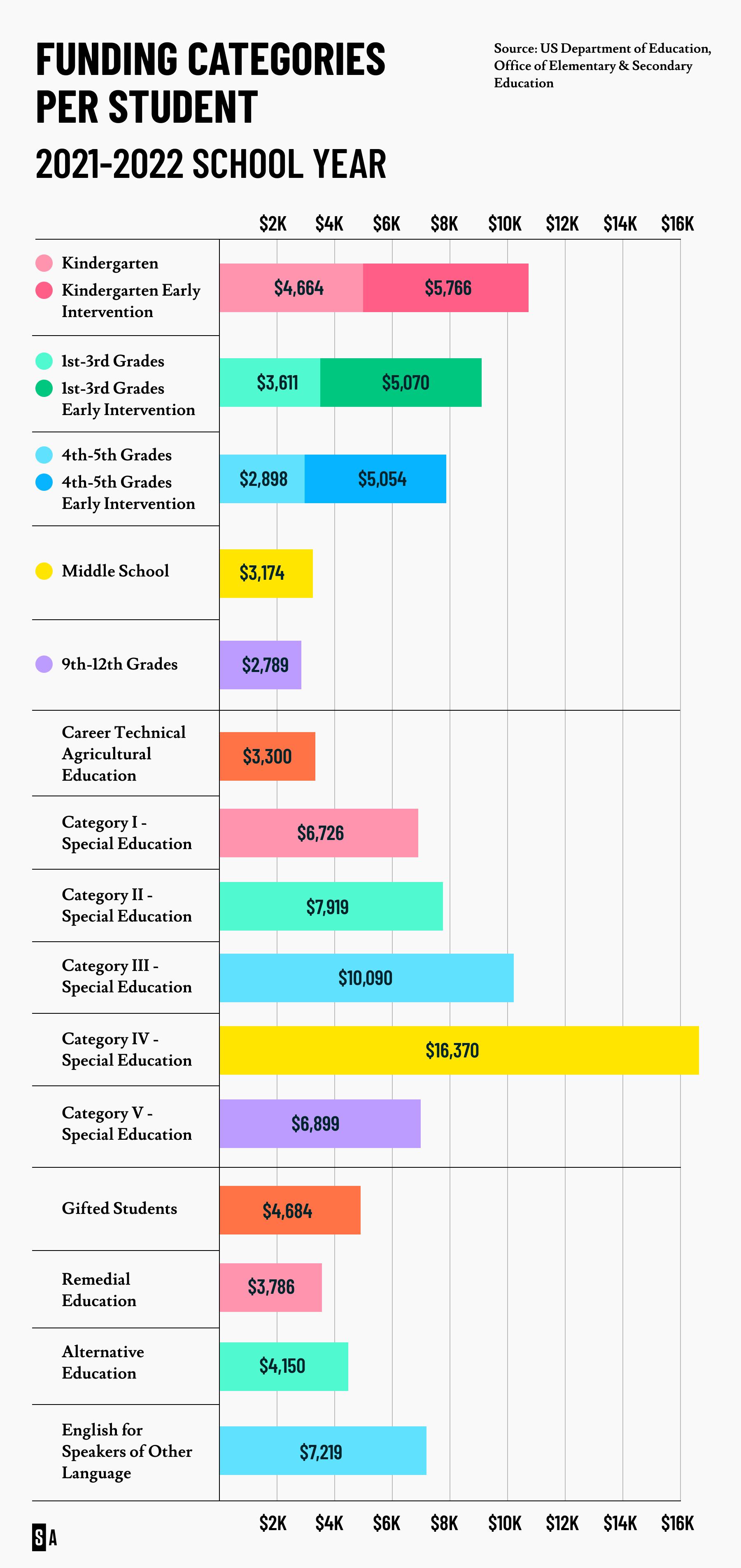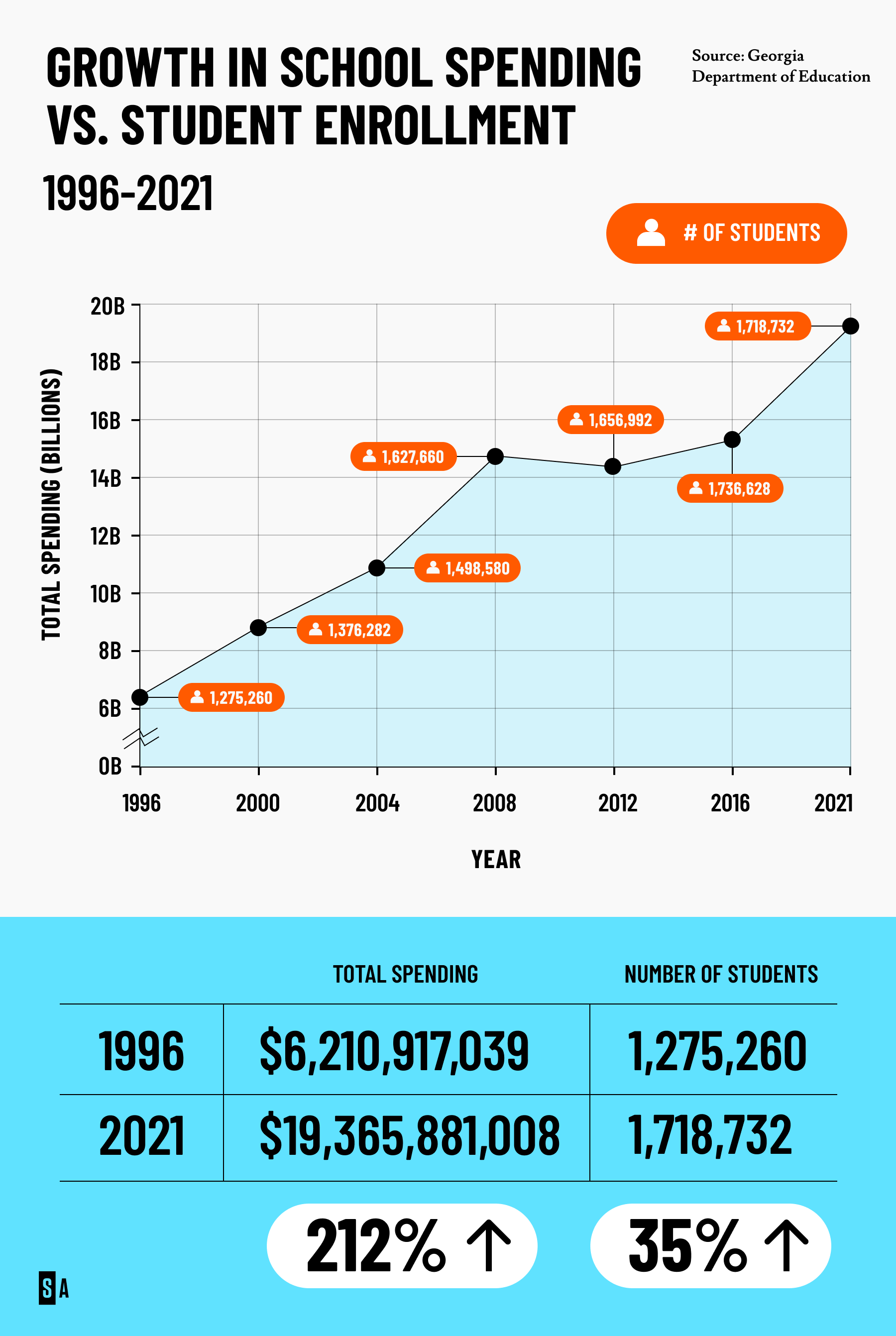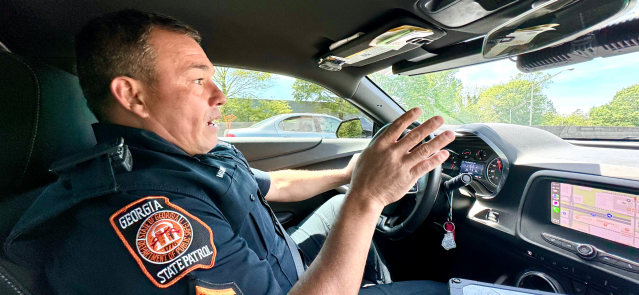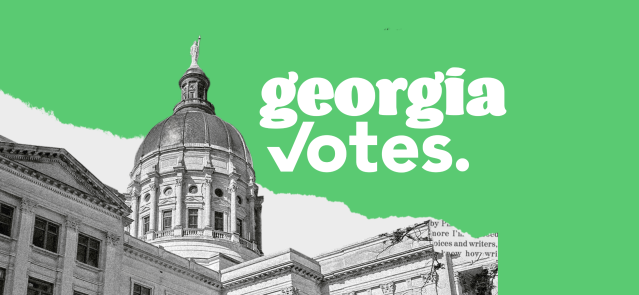Stay ahead of the curve as a political insider with deep policy analysis, daily briefings and policy-shaping tools.
Request a DemoDo Georgia’s low-income students need more state school funding?

Illustration by Brittney Phan (State Affairs)
- More than half a million Georgia students live in poverty or other underprivileged situations.
- Georgia is one of only six states that do not factor low-income students in its school-funding model.
- Many state lawmakers and experts agree Georgia’s funding model needs an update – but no progress has been made.
Taxpayers spend billions of dollars each year on Georgia’s public k-12 schools, but none of the state’s education dollars goes specifically to kids from low-income families who often struggle in class, State Affairs has found.
Georgia is one of only six states that do not factor low-income students into their annual school-funding formulas – even as roughly one-third of Georgia’s roughly 1.7 million students in county and city public schools were classified by the state as living in poverty last year.
The omission has prompted some state lawmakers and policy experts to call for overhauling Georgia’s complex funding formula for schools. Others doubt the General Assembly has enough political will to change the nearly 40-year-old system that decides how to spread more than $12 billion among 2,300 local schools.
“We haven’t had someone take a hard look at what kids need, at least since I’ve been following it,” said Stephen Owens, a senior policy analyst with the nonprofit Georgia Budget and Policy Institute (GBPI) who focuses on education issues. “I think it comes from a fear that we will be shown to be far behind.”
In this story, State Affairs digs into Georgia's complex model for funding public schools and how many of the state's neediest children miss out on extra funding.

Georgia's school funding 'phone booth'
Benjamin Scafidi, an economics professor at Kennesaw State University who studies national trends in school finances, remembers stories of the grinding tug-of-war in 1985 between state lawmakers tasked with creating a new formula for public school funding.
Each new proposal prompted fresh calculations in the old computers of the budget office across from the Capitol building in Atlanta, spurring lawmakers to haggle over the final bill so that their own school district wouldn’t miss out on state tax dollars.
“That’s why it’s so difficult to change the formula,” Scafidi said. “If you change one comma, there’s winners and losers. And the losers are going to scream.”
What resulted was the “Quality Basic Education” formula, a complicated system that portions out billions of dollars based on a blend of schools’ student numbers and their academic programs. It ties dollar amounts to each student depending on their grade or special-education needs – but not based on whether they come from low-income backgrounds. In the current 2021-22 school year, schools received between roughly $2,800 and $4,700 in state funds for each student in kindergarten through 12th grade, plus higher amounts per student for programs in special education, academic intervention and English learners.
Those baseline per-student funding rates don’t cover all the math that goes into the formula, which many analysts and lawmakers agree is a tough system for anyone to understand.
“You could fit everybody who truly understands the QBE formula certainly in a room, maybe in a phone booth,” said Kyle Wingfield, president and CEO of the Georgia Public Policy Foundation (GPPF). “You’re fitting programs today into categories created all those years ago and it doesn’t even necessarily make sense anymore.”

Low-income students miss the math
While the formula covers basic educational needs, it doesn’t factor in students from low-income backgrounds whose grades stumble without extra help from teachers or tutors – which many schools can’t afford.
Georgia is an outlier among states for not including funding for low-income students in their school-funding models, joining Florida, Alabama, Arizona, South Dakota, Idaho and Alaska in not doing so, according to the nonprofit Education Commission of the States.
Last school year, around 541,000 students were “directly certified” by the state, a marker of Georgia’s student poverty levels that tracks kids whose families receive food stamps, housing assistance or are homeless. Additionally, more than half of Georgia’s k-12 students qualified for free and reduced meals – another marker of student poverty.
Schools with large shares of their students below the poverty line rank among the lowest in Georgia for testing and other academic-performance measures, state data shows. Out of 38 school districts with most of their students from low-income backgrounds, nearly all received “D” or “F” grades on the state’s most recent school report card – a metric that assesses test scores, graduation rates and students’ learning progress.
The lack of formula dollars for low-income students also widens funding gaps between schools in wealthy areas and those with higher poverty levels that local property taxes, equalization grants and federal aid don’t completely close, experts say.
Funding for Georgia’s highest-poverty schools is “severely inadequate,” totaling less than half the amount likely needed to help bring test scores up to the national average, according to a December 2021 study from the nonprofit Albert Shanker Institute and Rutgers University.
“We have these huge differences in how low-income kids are doing compared to kids who are not on free lunch,” GBPI’s Owens said. “There are higher costs associated with the higher needs of students.”
Piecemeal approach in the legislature
Amid issues for low-income students, recent efforts to tweak Georgia’s school funding have gone nowhere in the General Assembly – despite calls from many lawmakers and experts for an update.
Several changes to the formula proposed in 2011 by a commission backed by then-Gov. Nathan Deal failed to translate into actual legislation. The Georgia Chamber of Commerce also pitched a formula overhaul that would include more consideration for low-income students, but which didn’t gain traction in the legislature.
Instead, lawmakers have tackled school-funding issues in piecemeal fashion – but without much success. Deal’s proposal for the state to assume oversight of low-performing schools was struck down by voters in 2016, followed by the legislature’s creation of a new state office for turning around struggling schools that collapsed within three years.
Since then, the most sweeping proposed funding changes have come from state Rep. Wes Cantrell, R-Woodstock, who has a pair of school-voucher bills in the current legislative session that would allow students to use state funds for switching schools, home-schooling or tutor services.
Cantrell said his proposals would directly benefit students who are struggling in school, avoiding the tough sell needed to convince a majority in the General Assembly to change the funding formula.
“We can’t seem to move the needle with the formula,” Cantrell said. “So now, you have some counties that have a lot more than others, even with all the efforts to make it equal.”
Opponents worry student vouchers would send state dollars to private schools at the expense of public education. They want the state to take an in-depth look at how Georgia could spend its education funding in more effective ways – including whether schools currently have enough money for low-income students.
Meanwhile, many lawmakers like Georgia House Minority Leader James Beverly (D-Macon) support legislation that would create a new way for the funding formula to account for low-income students. A bill to do so has stalled recently in the legislature.
“That should be something we’re talking about right now,” Beverly said. “It would add a little bit more to the formula for school systems so we can make sure kids don’t fall through the cracks.”
What else do you want to know about the costs and taxpayer funding of Georgia's public schools? Share your thoughts/tips by emailing: [email protected].
Read this story for free.
Create AccountRead this story for free
By submitting your information, you agree to the Terms of Service and acknowledge our Privacy Policy.
‘It is nothing short of insane:’ Bill to criminalize squatting signed by governor
ATLANTA — Today Gov. Brian Kemp signed legislation criminalizing squatting, the illegal practice of entering and residing on someone else’s property without their consent. The Georgia Squatter Reform Act makes squatting a misdemeanor criminal offense, punishable by up to a year in jail, a $1,000 fine, or both. It also speeds up the timeline to …
State troopers are stretched to fight drugs and curb highway deaths
ATLANTA — When Cpl. Anthony Munoz straps on his bullet-proof vest each day and pulls out of the Department of Public Safety headquarters in Atlanta, Munoz never knows how his shift will unfold. What is for certain is that the traffic — of cars, criminals and contraband — is constant. And what is also true …
In hot water with your HOA? A new law buys you time to fix the problem
The Gist
Georgia homeowners living in communities governed by homeowners’ associations now get time to fix a covenant violation before the HOA can take legal action, thanks to legislation signed into law Monday.
Gov. Brian Kemp signed House Bill 220 at the Capitol, continuing his flurry of bill-signings across the state. To date, Kemp has signed about three dozen bills since sine die, which marked the end of the 2024 legislative session, his spokesman Garrison Douglas told State Affairs. Sine die ended in the early hours of March 29. The governor has until May 7 to sign, veto or take no action on a bill. If he takes no action, the bill automatically becomes law.
What’s Happening
HB 220 requires community-governed associations to notify in writing a home or condo owner of a covenant breach — such as painting their house a color not approved by the association, and give them time to fix it before going to court or taking some other legal action.
Rep. Rob Leverett, R-Elberton, sponsored the bill which included parts of an HOA bill promoted by Sen. Donzella James, D-Atlanta. James had been trying for two years to get some HOA-related legislation passed.
While the HOA portion of HB 220 does not go as far as James’ proposed single legislation, it’s a start, she and others say.
Why It Matters
An overwhelming majority of new subdivisions being built in Georgia now will have HOAs, experts told State Affairs. In fact, new homes that are part of a homeowner association are growing fastest in the southern and western part of the United States. An estimated 2.2 million, roughly 22%, Georgia residents live in a building or home overseen by anHOA or some other type of community association, according to the Community Association Institute.
Lawmakers such as James have heard complaints in which HOAs have terrorized homeowners and threatened to take their property, all while homeowners have had little to no legal options. In some cases, homeowners have lost their homes after falling behind on HOAs fees, even if they never missed a mortgage payment.
What’s Next?
While HB 220 is now law, Senate Resolution 37 has yet to be appointed. The resolution, sponsored by James, creates the Senate Property Owners’ Associations, Homeowners’ Associations, and Condominium Associations Study Committee. Committee members will be appointed by the President of the Senate, Lt. Gov. Burt Jones.
Lawmakers appointed to the committee will delve further into HOA issues before presenting recommendations to the Legislature when it convenes in January.
See related stories:
Have questions? Contact Tammy Joyner on X @lvjoyner or at [email protected].
And subscribe to State Affairs so you do not miss any election news you need to know.
X @StateAffairsGA
Facebook @StateAffairsGA
Instagram @StateAffairsGA
LinkedIn @StateAffairs
All you need to know heading into the May 21 primary
Gist
Georgia’s primary is less than a month away and there’s a lot to unpack.
The May 21 primary will be the first time some Georgians will be voting in new districts for state and congressional candidates. They’ll also be voting in local races for sheriff, judges, school board or county commission members. Primary winners who have challengers will go on to compete in the Nov. 5 general election. Georgia is an open primary state, meaning voters can choose the party ballot they wish to vote for.
This year, Georgians who want to vote absentee in the primary could face possible challenges due to mail delivery delays.
What’s Happening
North Georgia and metro Atlanta are seeing significant mail delivery delays. The holdup, according to media reports, appears to be at the United States Postal Services’ new Regional Processing and Distribution Center in Palmetto. The problem has led to dangerous situations in which people are not getting critical medication.
Georgia’s U.S. Sen. Jon Ossoff recently grilled USPS Postmaster General Louis DeJoy on the delays. Ossoff told DeJoy during an April 16 hearing that on-time delivery rates were abysmal. He said 66% of outbound first-class mail had been delivered on time while 36% of inbound mail had been delivered on time in the last three months.
DeJoy blamed the problem on the difficulty in condensing operations at the facility.
With the approaching primary, state lawmakers are concerned the ongoing mail delays could disrupt the election process.
Mike Hassinger, a spokesman for the Secretary of State’s office, told State Affairs that Georgia voters are ready.
“Georgia voters are already registered,” he said. “They know how they like to vote. More than half of them vote early. About 5% vote absentee by mail, just in general, and then the rest are voting on election day. So we’ve been able to set up systems that are familiar with Georgia voters so that the percentage who might be worried about their absentee by mail ballots are relatively small.”
Why It Matters
Georgia emerged as one of the country’s most important political battleground states during the 2020 election. The Peach State will once again play a key role in deciding who wins the 2024 presidential election in November.
In the May 21 primary, Georgia voters will whittle down their choices for who they send to Congress and to the state capitol next year.
Under a federal court-approved redistricting process last year, Georgia now has new congressional and state district electoral maps. Those maps created one majority Black seat in the U.S. House of Representatives, five new majority-Black districts in the state House and two in the state Senate.
The redistricting resulted in new seats, intriguing matchups and former politicians returning to the fray. You can see the newly drawn maps here.
What’s Next?
Here’s what you need to know to ensure a smooth voting process:
To vote early.
Early voting is April 29 to May 17. Find your polling place here.
To vote absentee.
Here’s what you can do to avoid problems if you vote absentee:
- Get your absentee ballot application done early. You can request an absentee ballot here.
- Track your application through Georgia BallotTrax. You must have a valid absentee request on file with your county board of elections in order to see your absentee ballot status in Georgia BallottTrax.
- If you’ve been having mail delays, place your completed absentee ballot in an official drop box during advanced voting instead of using the United States Postal Service. Check your county voter registration and election office for drop box locations. And yes, your absentee ballot counts. It is counted in the final tally not just close races.
- If you change your mind about voting absentee and decide to vote in person, take your absentee ballot to your local elections office where they will void it.
- If you need to contact your county election office, find that information here.
Have questions, comments or tips? Contact Tammy Joyner on X @lvjoyner or at [email protected].
And subscribe to State Affairs so you do not miss any news you need to know.
X @StateAffairsGA
Instagram@StateAffairsGA
Facebook @StateAffairsGA
LinkedIn @StateAffairs




